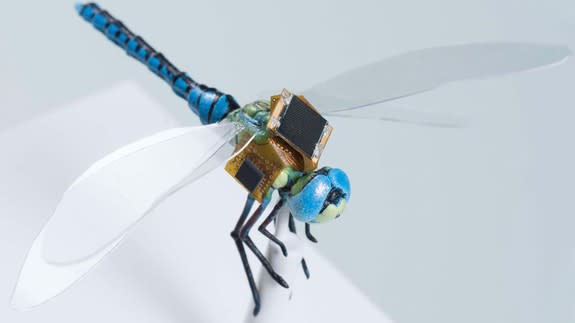Scientists are turning dragonflies into tiny cyborg drones

One company has decided the ideal tiny drone should take its cues from the natural world of insects — specifically the dragonfly.
When Draper, an independent biomedical solutions lab, set out to make its own mini-fliers, it cut out the middleman. It got some of the insects and outfitted them with cutting-edge navigation, synthetic biology and neurotechnology systems to create a swarm of cyborg dragonfly drones.
SEE ALSO: Pocket-sized Dobby selfie drone is cute, tiny and way frustrating
The tiny hybrids are part of an internal R&D project at Draper called, appropriately, DragonflEye.
"DragonflEye is a totally new kind of micro-aerial vehicle that’s smaller, lighter and stealthier than anything else that’s manmade,” said the program's principal investigator Jesse J. Wheeler in an interview posted online by the company. “This system pushes the boundaries of energy harvesting, motion sensing, algorithms, miniaturization and optogenetics, all in a system small enough for an insect to wear."
The tech is all miniaturized in a tiny pack, which is fitted onto the insects' midsections. The system, which was developed in part with Howard Hughes Medical Institute, sends guidance commands to neurons inside the dragonfly nerve cord that are associated with navigation. It essentially takes control of the dragonfly's flightpath, giving the Draper team the ability to guide the insect wherever they want it to go.
The Draper team is also developing specialized optical structures called optrodes that will be used to target the exact neural systems needed to take the cyborg where it needs to go without disrupting the rest of the dragonfly's neural network.
The tech has a wide range of potential applications outside of just controlling a dragonfly's flight path — along with the obvious surveillance and intelligence uses, the tech behind the drones might someday be applied to the world of (human) medicine.
More immediately, the same type of tiny drone design could be put to use on another flying insect: bees. Seven species of bees were added to the endangered species list last year, even while bee pollination alone provides over $15 billion in value to agricultural crops each year in the United States, according to a 2014 White House memorandum. By putting the DragonflEye's tech on honeybees, researchers could gain more insight on the insects and help to manage the population.
